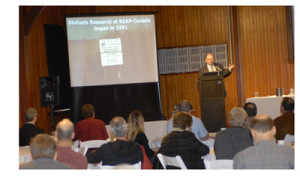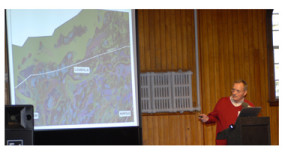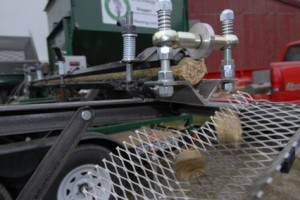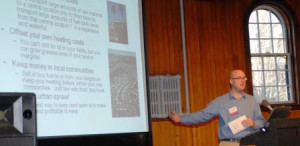Grass Energy Symposium (2008)
November 12, 2008 — Shelburne Farms, Vermont
This event was funded, in part, by the US Department of Energy, courtesy of U.S. Senator Patrick Leahy, and was generously hosted by Shelburne Farms.
Event Organizers: VSJF, Biomass Energy Resource Center, University of Vermont Extension.
Click on the names of the panelists below to download their presentations.
Additionally, for ongoing discussion about the current state and future of grass energy (growing, harvesting, processing, pelletizing, and combustion) as a renewable biomass fuel, you can join an online discussion group here: Grass Energy Google Group.
 Keynote Address: Building a Viable Grass-Energy Economy
Keynote Address: Building a Viable Grass-Energy Economy
Roger Samson, Executive Director of R.E.A.P.-Canada.
Mr. Samson is an internationally recognized leader in grass energy, working with perennial grasses, agri-fibers, agro-forestry, biomass combustion systems, and fuel pelletization. There is a tremendous need for low cost energy around the world, and since 1986 R.E.A.P. Canada has been working to efficiently capture solar energy and convert it as efficiently as possible into usable energy forms.
R.E.A.P. Canada has focused on pelletizing switchgrass, big bluestem, and other grass crops for thermal combustion. Switchgrass and big bluestem are native, perennial, warm season grasses that have high moisture and nutrient use efficiency. Cave in Rock is the standard switchgrass variety in New England.
Samson identified four main drivers for creating a grass biofuel industry:
- technology development (e.g., improvements in densification and boiler technology);
- policy (e.g., renewable energy incentives applied to grasses and/or carbon regulations);
- capacity development and consumer education (training and awareness); and
- market analysis / development and government regulation (e.g., new fuel quality and boiler emissions standards).
 Panel 1: Growing and Harvesting
Panel 1: Growing and Harvesting
- Jerry Cherney, E.V. Baker Professor of Agriculture Department of Crop & Soil Sciences, Cornell University
Dr. Cherney’s current research features 3,000 switchgrass and reed canarygrass plants in plots in New York. Cherney used a pilot / flight attendant analogy to describe the grass energy situation in the United States compared to Europe. He argued that Europe has institutional drivers (pilots) in the form of energy policy, an emphasis on energy returned on energy invested, grass energy legislation, and standards that have assisted in the development of the European grass energy industry. The U.S., on the other hand, has informational drivers (flight attendants) in the form of researchers and educational activities. In other words, the U.S. has flight attendants but no pilots.
Under these conditions, Cherney argued that we’re going to have a grass pellet industry because Europe wants it (i.e., U.S. feedstocks will be exported to Europe). Alternatively, he believes that a small to medium scale grass energy industry that emphasized local production for local use is possible in New England.
Read Dr. Cherney’s presentation here.
- Pamela Porter, Principal, P Squared Group; Midwest Office Director, Biomass Energy Resource Center
Pam Porter’s presentation focused on Midwest biomass trends.
- Roger Samson, Executive Director, R.E.A.P.-Canada
Samson’s presentation focused on problems with high potassium and chlorine content in grasses, which causes agglomerations and corrosion in boilers. A solution that R.E.A.P. Canada has identified is using warm season grasses under delayed harvest management (i.e., ‘overwintering’) to leach the potassium out.
Lunch Keynote: A Systems Approach to Sustainable Agriculture and Energy

1.5 inch grass rounds come tumbling down BHS Energy’s mobile pelletizer at the Grass Energy Symposium.
Will Stevens, Golden Russet Farm
Panel 2: Processing and Pelletizing
- Daniel P. Arnett, Biomass Coordinator, Ernst Conservation Seeds
Dan Arnett describes the benefits of densification for transportation, storage, and standardization during his presentation. Ernst Conservation Seeds is the largest grower of switchgrass east of the Mississippi.
- Bryan Reggie, Managing Member, Electrical Engineer, BHS Energy LLC

Bryan Reggie enumerates the benefits of local biomass during his presentation, including offsetting heating costs.
Mr. Reggie and partners have developed a mobile grass briquetter that makes 1.5 inch grass rounds (see below). BHS Energy anticipates a market for medium-scale densification from farmers with 100+ acres or coops; greenhouses with 50+ acres of farmland; municipalities; and ag related businesses.
John Arsenault, Vice President of Quebec Operations, Energex Pellet Fuel, Inc.
Energex Pellet Fuel has been making wood pellets since 1982. 95% of the pellets are exported to the U.S.
- Steve Flick, Board President, Show Me Energy Cooperative
Panel 3: The State of Combustion Technology
- Jerry Cherney, E.V. Baker Professor of Agriculture Department of Crop & Soil Sciences, Cornell University
Read Dr. Cherney’s presentation here.
- Andy Boutin, Founder and General Manager, Pellergy, LLC
Mr. Boutin’s talk highlighted technology gap areas, including the standardization of the fuel, fuel handling and storage, combustion techniques, ash control, heat exchanger surfaces, and air pollutants.





